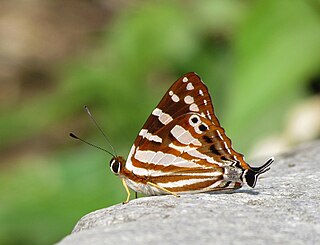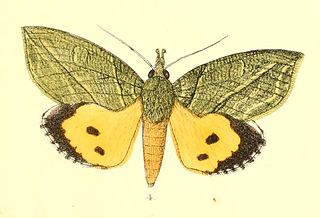
Graphium antiphates, the five-bar swordtail, is a species of papilionid butterfly found in south and southeast Asia. The species was first described by Pieter Cramer in 1775.

Dodona durga, the common Punch, is a small but striking butterfly found in the Indomalayan realm that belongs to the Punches and Judies, that is, the family Riodinidae.

Dodona egeon, the orange Punch, is a small but striking butterfly found in the Indomalayan realm - in Mussoorie to Assam, Burma (nominate) and Peninsular Malaya that belongs to the family Riodinidae.

Polyura eudamippus, the great nawab, is a butterfly found in India and the Indomalayan realm that belongs to the rajahs and nawabs group of the brush-footed butterflies.

Castalius rosimon, the common Pierrot, is a small butterfly found in India that belongs to the lycaenids, or blues family.

Tarucus theophrastus, the common tiger blue, pointed Pierrot or African Pierrot, is a small butterfly found in the Old World tropics. It belongs to the lycaenids or blues family.

Jamides celeno, the common cerulean, is a small butterfly found in Indomalayan realm belonging to the lycaenids or blues family. The species was first described by Pieter Cramer in 1775.

Hypolimnas misippus, the Danaid eggfly, mimic, or diadem, is a widespread species of nymphalid butterfly. It is well known for polymorphism and mimicry. Males are blackish with distinctive white spots that are fringed in blue. Females are in multiple forms that include male-like forms while others closely resemble the toxic butterflies Danaus chrysippus and Danaus plexippus. They are found across Africa, Asia, and Australia. In the new world they are found in the West Indies, with strays in Central and North America.

Curetis bulis, the bright sunbeam, is a species of butterfly belonging to the lycaenid family. It is found in Asia.

Hypermnestra helios is a species of swallowtail butterfly belonging to the Parnassinae family and is the sole member of the genus Hypermnestra. It is found in Iran, Afghanistan, Pakistan, Turkmenistan, Kirghizstan, Tajikistan, and Uzbekistan. It is locally common in desert habitats.

The Indian fritillary is a species of butterfly of the nymphalid or brush-footed family. It is usually found from south and southeast Asia to Australia.

Nymphalis xanthomelas, the scarce tortoiseshell, is a species of nymphalid butterfly found in eastern Europe and Asia. This butterfly is also referred as yellow-legged tortoiseshell or large tortoiseshell.

Apporasa is a genus of butterflies in the family Lycaenidae, the blues. The genus is monotypic containing only Apporasa atkinsoni, the crenulate oakblue. It is found in the Indomalayan realm.

The Latin(Callopistria juventina) is a moth of the family Noctuidae. The species is found across the Palearctic realm.

Catocala nymphagoga, the oak yellow underwing, is a moth of the family Erebidae. It is found in Southern Europe, from Bulgaria up to the Iberian Peninsula and sometimes further north as a migrant. It is also found in North Africa and Asia Minor.

Eudocima hypermnestra is a moth of the family Erebidae described by Pieter Cramer in 1780. It is found in China, Thailand, Taiwan, India and Sri Lanka.
Bocchoris rufiflavalis is a moth of the family Crambidae. It can be found in Madagascar.
Ambia albiflavalis is an African moth in the family Crambidae. It was described by George Hampson in 1917. The type locality is Nigeria.
Ambia chrysogramma is a moth in the family Crambidae. It was described by George Hampson in 1917. It is found on Samoa.
Sinomphisa junctilinealis is a moth in the family Crambidae. It is found in Sierra Leone and Uganda.















